There are approximately 2,500 species of termites worldwide. Most are found in tropical areas, while relatively few live in colder climates. Only about 45 species are found in the United States, and most of these are located in southern states. Four species of termites are reported to occur naturally in Missouri. All of these species are closely related and belong to the genus Reticulitermes.
Termites are generally grouped into categories based on the habitat in which they live. Drywood and dampwood termites live inside wood of varying levels of decay and moisture content. Subterranean termites live in the soil and wood that is in contact with soil. All of Missouri's native Reticulitermes termites are subterranean. Subterranean termites are found throughout most of the continental United States, while wood-dwelling species occur in the coastal and southernmost tier of states. Wood-dwelling termites can be introduced into other locations of the country through the transport of wood products, although they normally do not spread or become established in these locations.
In natural ecosystems termites are considered beneficial because they help release nutrients from dead wood and other cellulose materials into the soil. In human environments, they are considered serious pests. Due to their widespread distribution, subterranean termites are responsible for most of the termite damage caused annually in the United States. Approximately $4.5 billion is spent annually in the United States to control subterranean termite infestations and repair damage they cause. The most common house-infesting termite in the United States is Reticulitermes flavipes, the eastern subterranean termite (Figure 1).
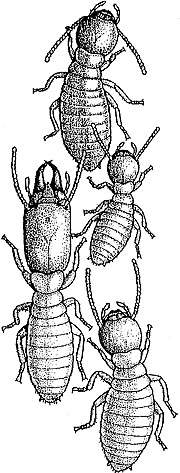 Figure 1
Figure 1
Subterranean termite (Reticulitermes spp.) workers and soldier.
Biology
Termites are social insects like ants, bees and wasps. Social insects live in large groups, share a nest and share important biological roles among individuals within a colony. In termite colonies, important biological roles are divided among physically distinct termites called castes. Termite castes include eggs, larvae, workers, soldiers, nymphs and reproductives (Figure 2). The percentage of the colony in each caste is regulated by chemical signals, which vary between different species and groups of termites.
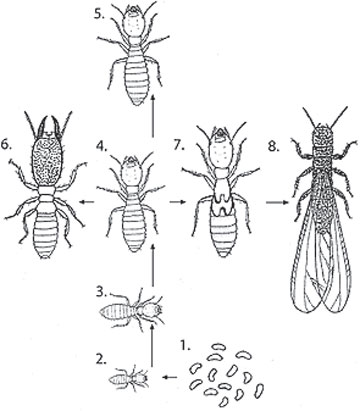 Figure 2
Figure 2
Life history of subterranean termites (Reticulitermes spp.). After hatching, termites may pass through many, but not all, of the stages shown here. These stages are
- Eggs
- Larva
- Larva
- Worker
- Worker
- Soldier
- Nymph
- Swarmer
Reproductives
This is the adult caste that produces offspring. There is always at least one male and one female in an active colony. Primary reproductives are shiny brownish to black in color. They are produced in mature colonies and emerge at certain seasons of the year to make dispersal flights. During the period they are called swarmers (Figure 2). Swarmers are seldom produced until the colony is more than three years old.
In the case of the eastern subterranean termite, swarming flights occur in Missouri during the spring months, usually on a warm, sunny day following rain. Sometimes, termite swarmers are confused with ant swarmers during this time, but the two are easily distinguished from one another (Figure 3). After flying away from their home colony, termite swarmers shed their wings and pair up. Each pair starts a new colony by constructing a protective cell in the soil adjacent to wood or other food source. Mating and egg production begin in this cell. These activities constitute the beginning of a new subterranean termite colony.
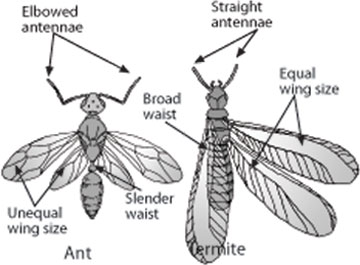 Figure 3
Figure 3
Differences in body form between winged termites and winged ants. Winged termites are distinguished by
- Four cloudy-white, equal-sized wings
- Straight antennae
- A waist equally as broad as the rest of the body
Winged ants are distinguished by
- Four clear, unequal-sized wings
- Bent antennae
- A waist that is narrower than the body
Eggs
Subterranean termite queens lay clusters of eggs (Figure 2), which look like small, translucent jelly beans. The reproductives care for the first batch of eggs, but thereafter, worker termites care for the eggs, keeping them clean from bacteria, fungi and other microorganisms in the soil.
Larvae
These are small termites that have just hatched from the egg and have not molted more than once (Figure 2). They are characterized by their small size, soft head capsules and mouthparts, and their absence of coloration. They are dependent on worker termites to feed them.
Workers
Also called pseudergates, these termites are creamy white and soft bodied, with a darker head and hardened mouthparts (Figure 2). Workers are the most common caste in a termite colony and are responsible for many of the activities in the colony. Workers locate and consume wood, feed and groom the other castes, and build and repair tunnel systems. Because subterranean termites are susceptible to drying out when exposed to open air, the nest-building activities of the worker caste are critical for colony survival. In addition to tunneling, subterranean termite workers build shelter tubes to serve as protected passageways from the soil to aboveground food sources.
Even after reaching maturity, workers continue to molt periodically throughout their lives with no increase in size. After every molt, workers get a new set of mouthparts. If isolated, individual workers may molt into a stage that is capable of reproduction. Workers that go through this change are called tertiary reproductives.
Soldiers
Relatively few soldiers are found within a colony. They are responsible for colony defense. Their enlarged heads and long mandibles are adapted to plug holes in the tunnels and inflict a painful bite on invading enemies (Figure 2). Soldiers rely on the worker caste to feed them.
Nymphs
Termites in this caste are preparing to molt into fully winged termites and leave the nest to start new colonies (Figure 2). If isolated during this stage, individual nymphs can become capable of reproduction. Nymphs that go through this change are called secondary reproductives.
Infestations/Feeding
Subterranean termites invade homes from the soil around and beneath the structure. Infestations occur when subterranean termite workers locate structural wood in contact with soil or when termites build shelter tubes from the soil across foundation walls and into structural wood. Subterranean termites may also gain access through cracks in the slab or seams where plumbing and electrical lines penetrate the concrete. Foundations made of hollow blocks, or of masonry and rock provide several avenues for termites to gain undetected access to wooden parts of the structure. Once inside, subterranean termite colonies maintain access to the soil around or under a home. The soil provides them with the necessary moisture to remain healthy.
Subterranean termites do not cause significant damage over a period of days or weeks. It typically takes several months or years of feeding for termite damage to be significant. Termites prefer to feed on the soft grain of the wood. In severely infested wood, only the hard grain and a thin outer shell remain. Termites intentionally remain hidden within infested wood, preferring not to be exposed to the outside environment. This makes it difficult to locate infested wood in a structure. An infested timber can look perfectly normal on the outside, even when riddled with termite galleries on the inside.
Subterranean termite damage has a distinctive appearance. An active infestation is recognized by the presence of live termites and a fecal-soil mixture within the tunnels. This soil mixture is brought into the tunnels to help maintain humidity. In active infestations, this soil looks moist. In old damage, the soil in the tunnels looks dry. It is impossible to determine how old termite damage is by looking at the infested wood. A survey of the extent of damaged wood throughout a home is generally more helpful in determining the length of time associated with an infestation. In general, large areas of damaged wood indicate longer-term infestations, while smaller areas of damage may indicate less time since infestation.
To check for termites, probe any wood near the foundation or soil with a sharp screwdriver. Pay close attention to sill plates, header joists, ends of floor joists, bases of wall studs and flooring. Termite-damaged wood offers little resistance to the probe. The presence of earthen shelter tubes on a foundation wall or wood is also evidence of infestation. The presence of large numbers of swarmers inside a structure is a sure sign the structure is infested. If you find damage, there is no hurry to apply control measures. Termites work slowly, and a few weeks of delay are of little consequence. Use this time to carefully select a management strategy and commercial pest management professional (PMP) to treat the infestation.
Management: Preconstruction
To minimize the risk of infestation by subterranean termites, consider three important principles while a home is being built:
- Sanitation
- Good construction practices
- Termite barriers
Sanitation
Eliminating wood debris during construction removes potential food sources subterranean termite colonies need to survive and invade. It is important to remove grade stakes, form boards and all other wood scraps from the soil around a new home before the backfill is pushed against the foundation. You also need to ensure that there is no wood placed under porches, steps and patios as filler. If construction scraps are placed in these locations, it provides an ideal place for termite colonies to establish and grow adjacent to your home. From these hidden areas, it is easy for termites to infest flooring, door frames, wall studs and sill plates. Insist that construction scraps are removed regularly during the building process.
Areas of consistently moist soil along a foundation wall provide good termite habitat. To minimize this, the finished grade should always slope away from the foundation for good water drainage. Downspouts should be directed away from the foundation walls to minimize pockets of moisture along a foundation. In buildings with crawl spaces, sufficient ventilation outlets for air movement are important in keeping the soil dry underneath the home.
Construction
A poured, reinforced, crack-free concrete foundation is the best deterrent to termite infestation. Solid concrete foundations and basements are recommended. Hollow-block and brick foundations have many internal passageways for termite infestation and thus are discouraged. However, if installed, these foundations should be capped with at least 4 inches of concrete to provide a barrier to termite invasion. Rock foundations develop many potential entry routes as the mortar ages and cracks appear.
Avoid wood-to-soil contact. No wood should ever extend into or through concrete to the soil. This provides an ideal point for termites to enter structural wood undetected below the foundation. Make sure basement partition walls, posts and stair stringers are not put into place until after the concrete floor has been poured. Porch supports and wooden steps should rest on concrete bases that extend above the soil.
Never allow siding to extend below the soil surface. Termites can enter the wall behind siding undetected. Even if the siding isn't edible, termite tubes will be shielded from view. Always insist that 4 to 6 inches is maintained between the soil surface and the bottom edge of siding, brick veneer, or other outer wall coverings. In this case, mud tubes will be visible upon inspection. Styrofoam insulation placed on the outside of the foundation and basement walls, and which extends up behind the siding, is discouraged because it provides a pathway for termites to enter a wall undetected.
Using treated wood for construction of components that are most susceptible to termite attack is recommended. Treated lumber should always be used in locations such as sill plates or mudsills. Treated woods provide adequate protection, but remember that termites can build mud tubes over treated wood and gain access to untreated areas of the structure. Most wood treatments are intended for prevention of fungal decay. You can apply disodium octaborate tetrahydrate (Bora-Care, Tim-Bor) to protect unfinished wood from termite attack. This borate salt is applied either by dipping or spraying the wood. If properly applied, borates penetrate deep into the wood. Borates are normally applied as coarse sprays to framing during construction. When borate-treated wood is exposed to moisture, borates leach out and render the wood susceptible; so treated framing should not be exposed to rain.
Note:
As of Jan. 1, 2004, CCA-treated wood is no longer available for use in most residential settings.
Barriers
Even with the best construction practices, homes remain susceptible to termite infestation. Termites can enter through cracks or gaps in the foundation as small as 1/32 inch. Cracks eventually form in nearly all foundations. Small gaps also occur around plumbing and electrical penetrations. Termites can go through gaps where concrete sections come together at expansion joints. Because termites can exploit these tiny openings, a chemical barrier against termite tunneling may be desired at the time of construction.
The time just before pouring the foundation is the best time to establish an effective chemical barrier against termite invasion because it minimizes the size and number of untreated soil gaps termites can exploit to gain entry into the structure. Soil under the foundation can be soaked thoroughly with termiticide before placing the vapor barrier. This creates a zone of treated soil to protect susceptible areas of the foundation. In addition to treating the soil, there are products available that incorporate termiticide into the vapor barrier itself. In any case, a termiticide barrier should not be considered as a substitute for good construction methods.
Commercial PMPs treat several areas during a preconstruction treatment. These areas include but are not limited to the soil beneath concrete slabs, including garage floors, porches and patios; soil adjacent to the foundation or basement walls; and soil near sewer and other utility lines that penetrate finished concrete.
Note:
If a concrete block foundation is constructed, the voids inside individual concrete blocks should all be treated before a concrete cap is poured on top.
Management: Postconstruction
Soil treatments and termite baiting systems are the primary treatment options to consider in postconstruction termite elimination. Although both are effective, the goals, methods, costs and expectations are unique for each. Postconstruction termite treatments should be carried out by a licensed, commercial pest management professional (PMP). There are no do-it-yourself termite control measures that effectively achieve the desired results. Commercial PMPs have the necessary equipment and access to the best technologies and products available for subterranean termite management.
Soil treatments
The goals of a soil treatment are to eliminate the current infestation and prevent termites from infesting the structure again in the future. This is accomplished by treating soil adjacent to potential termite entry points. Termites traveling between the structure and the soil are exposed to this treated soil, expose their nestmates to the toxin and succumb to the effects of the treatment. The effects of a soil treatment occur within the first few weeks after treatment.
Treating soil adjacent to a structure also provides long-term protection by isolating it to some degree from termite activity in the surrounding environment. Most commercially available termiticides remain active in soils for 5–8 years under normal conditions. Termites that tunnel into treated soils during this period would be unable to successfully establish within the structure.
When a soil treatment is used to eliminate subterranean termite infestations, several methods are used by the PMP, depending on the type of construction. Treatments differ between slab, crawl space and basement foundations (Table 1). Some of the methods associated with soil treatments can be invasive to the homeowner. In addition, large amounts of chemical are used in soil treatments. However, termite infestations are normally eliminated quickly, and residual protection continues for several years.
Table 1
Soil treatment methods for common construction types in Missouri.
Slab
- PMPs treat the soil under the perimeter of the slab and around the perimeter of the home. A trench 6 inches deep and 6 inches wide is dug along the foundation around the perimeter of the home.
- This trench is filled with termiticide, which soaks the soil downward along the foundation. A special rod is used to inject termiticide below the trench to the foundation footing.
- Holes 1/2 inch in diameter are drilled at 1-foot intervals through the slab around the inside perimeter of the house. Soil below the holes is treated using a rod that extends through these holes. After treatment, these holes are filled with concrete.
- Treated soil is placed back in trench.
Crawl space
- PMPs treat soil along the inside and outside perimeter of the foundation.
- Trenches 6 inches wide and 6 inches deep are dug along all interior and exterior foundation walls and supporting piers. Trenches are filled with termiticide, which soaks the soil downward along the foundation to the footing. A special rod may be used to inject termiticide around the footing.
- Treated soil is placed back in trenches.
Basement
- PMPs treat the soil under the perimeter of the basement floor and around the outside of basement walls.
- Exterior foundation walls are treated by filling a trench with termiticide for downward soaking. A rod is used to inject termiticide to the footing, or a depth of 4 feet, whichever is less.
- 1/2 inch-diameter holes are drilled through the floor at 1-foot intervals around the inside perimeter of the basement. Soil below the holes is treated using a rod that extends through the holes. Drilling and treating is also done along one side of weight-bearing walls. After treatment, these holes are filled with concrete.
- Treated soil is placed back in trench.
Termiticides used in soil treatments differ in the way they affect termites and are classified in two categories:
- Repellents are engineered to be detected by termites and intended to keep termites from entering a treated zone
- Nonrepellents are designed to escape detection by termites and allow termites to enter treated soil.
There is no mortality associated with repellent termiticides, while mortality occurs when termites tunnel into soils treated by nonrepellent termiticides. Differences in repellency are critical when deciding which termiticides should be used for pre- or postconstruction soil treatments (Table 2).
Table 2
List of some common registered termiticides and recommendations for use in either pre- or postconstruction soil applications. All of these products are for use by a licensed pest management professional.
Termiticide
Biflex TC
- Active ingredient
Bifenthrin - Effect
Repellent - Recommended use
Preconstruction
Demon TC
- Active ingredient
Cypermethrin - Effect
Repellent - Recommended use
Preconstruction
Dragnet FT
- Active ingredient
Permethrin - Effect
Repellent - Recommended use
Preconstruction
Phantom
- Active ingredient
Chlorfenapyr - Effect
Nonrepellent - Recommended use
Preconstruction
Postconstruction
Prelude
- Active ingredient
Permethrin - Effect
Repellent - Recommended use
Preconstruction
Premise 75
- Active ingredient
Imidicloprid - Effect
Nonrepellent - Recommended use
Preconstruction
Postconstruction
Prevail FT
- Active ingredient
Cypermethrin - Effect
Repellent - Recommended use
Preconstruction
Talstar
- Active ingredient
Deltamethrin - Effect
Repellent - Recommended use
Preconstruction
Termidor 80
- Active ingredient
Fipronil - Effect
Nonrepellent - Recommended use
Preconstruction
Postconstruction
Torpedo
- Active ingredient
Permethrin - Effect
Repellent - Recommended use
Preconstruction
Tribute
- Active ingredient
Fenvalerate - Effect
Repellent - Recommended use
Preconstruction
Laboratory studies have shown that because there is no mortality associated with repellent termiticides, the colony continues its tunneling activities and is likely to find gaps of untreated soil (Figure 4). The same studies found that gaps in nonrepellent barriers were not exploited because exposure and subsequent mortality minimized termite tunneling (Figure 4). The soaking of soils when applying preconstruction barriers leaves fewer gaps than in postconstruction barriers. Therefore, when creating a preconstruction barrier, either repellent or nonrepellent termiticides can be used. However, only nonrepellent termiticides are recommended for postconstruction soil treatments.
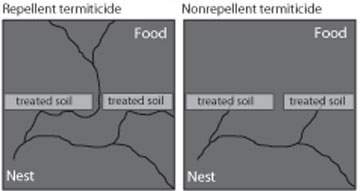 Figure 4
Figure 4
Differences between repellent and nonrepellent termiticides in the way they influence termite tunneling and ability to locate gaps in treated soils.
Baiting
The goal of baiting is to eliminate termites in a structure by intercepting active termite colonies around the home and feeding them a toxic food source. This is accomplished by placing stations in the ground around an infested structure. The stations initially contain wood or some other food material. When termites find a station, the food material inside is replaced with bait that contains a slow-acting chemical toxicant. The colony feeds on the bait, passes it around through food-sharing, and later succumbs to the effects of the bait. The time needed to eliminate termite colonies with bait is unpredictable and may take a few or several months depending on the time needed for termites to locate the stations, consume the bait and transfer the toxicant throughout the colony.
PMPs normally follow step-by-step procedures in response to termite feeding activity in bait stations (Figure 5). It is normally recommended that a PMP check each station at monthly intervals. Regular follow-up by the PMP is an important part of baiting. Regular monitoring ensures that the bait system works effectively in the shortest possible amount of time. If long-term protection is desired, the homeowner must hire the PMP to continue monitoring after the initial baiting cycle. The cost of this monitoring makes baiting more expensive on average than soil treatments. However, it is generally less invasive because the stations are typically outdoors.
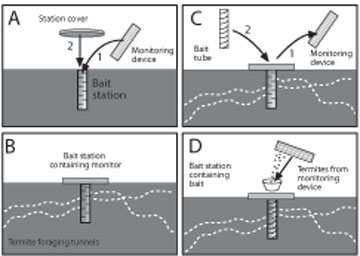 Figure 5
Figure 5
Steps followed during typical baiting cycle for subterranean termites include (a) station with monitoring device placed into soil; (b) termites discover and occupy the monitoring device in the station; (c) monitoring device is removed and bait is placed inside station; (d) termites from monitoring device are placed on bait inside station. (Adapted from M.J. Pearce, 1997. Termites: Biology and Pest Management.)
One necessary characteristic of all baits is that they must have a delayed effect to ensure sufficient time to pass the toxicant around the colony. However, bait toxicants vary in their toxicity to termites. Many bait toxicants are synthetic insect growth hormones (IGRs), while just a few are slow-acting poisons. IGRs interfere with termite development by causing the death of termite workers and nymphs during the molting process. Poisons interfere with normal functioning of certain body systems.
Soil treatments vs. baits
Soil drenches are fast-acting, provide some residual protection, and are usually less expensive than baits. However, when large amounts of termiticide are used around the structure, they can be invasive because of drilling. Baits have the advantage of being less invasive with smaller amounts of termiticide used. However, they take longer, there is no residual protection, and they are normally more expensive. Regular customer contact is not associated with soil treatments, while baits require the PMP to visit the home regularly. Some homeowners may feel frequent contact is a benefit, while others see it as a burden.
Hiring a licensed pest management professional
The most important choice you make when dealing with a termite infestation is the decision of which commercial PMP to hire. Do not base your selection solely on advertising or name recognition. Select a company based on reputation, quality of service and reliability. To know whether a company meets your expectations, personal contact is essential. Talk personally with representatives of at least three companies. You should talk to other people who have hired each company. You can call the Missouri Department of Agriculture Bureau of Pesticide Control to do a quick background check. You may even want to contact your local Chamber of Commerce or Better Business Bureau.
Each company should perform a thorough inspection beforehand and provide a description of the work to be done, chemicals to be used, details of any guarantees and estimated costs. Costs of inspections, treatments and service agreements often vary considerably between companies. It is better to avoid unusually high or unusually low estimates. Study all the information you receive, then base your decision on what is most important for your particular termite situation and which company you trust to do the work.
Most commercial pest management companies are reputable, legitimate businesses recognized by the state. Each company is required to have at least one person licensed to apply pesticides for specific pests or areas of your home. These individuals are required to be familiar with available pesticides, pass written examinations and regularly attend training sessions to renew their certification. The Missouri Department of Agriculture is responsible for licensing, training and monitoring the activities of commercial PMPs in our state.
- Missouri Department of Agriculture,
Bureau of Pesticide Control
P.O. Box 630
Jefferson City, MO; 65102
573-751-9198.
Questions to ask a pest management company
- How long have you been in business at your present location?
- How many years experience does the person performing the treatment have?
- Can I have a list of references?
- Do you have proof of licensing by the state of Missouri? May I have a copy?
- Do you have proof of insurance? May I have a copy?
- Are you a member of a professional pest management association? Which one?
- May I have a copy of the label for the termiticide you are planning to use?
Avoid companies that
- Do not have a listed or working phone number.
- Arrive uninvited and show you termites found in your neighborhood.
- Quote a per-gallon price.
- Offer a special price if treatment is done immediately.
- Offer a reduced price since they have excess material left from a previous job.
- Claim to have a secret formula. There are no secret formulas for termite control. All legal termiticides are registered by the U.S. Environmental Protection Agency.
- Want you to sign a contract immediately, hinting that your home is structurally unsound.
- Target the elderly, the infirm or those living alone.
- Claim to be "endorsed" by a government agency